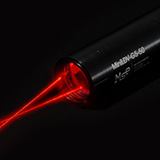| about | products | solutions | publications | contact | |
|
LDV/LDA microS microV miniPCS |
|
how an LDV/LDA works |
 |
"D" is for DopplerThe second explanation reveals how the "Doppler" in LDV/LDA comes about. When a particle travels through the probe volume, it will have some velocity V. If the vectors corresponding to the directions of the two beams are decomposed into a coordinate system where V is the X axis, then there will always be one beam whose "V-vector" is positive when the other one's is negative. Really this is a mathematical way of saying that the particle is always traveling "toward" one beam and "away" from the other. Much like the red and blue shift of galaxies moving away from or toward us, the particle will add a Doppler shift to the light it reflects from each beam: the frequency of the reflected light is higher for the beam toward which it's traveling and lower for the other. This is exactly like the pitch of a siren being higher when the ambulance is coming toward you than when it's going away from you. The frequency of light is extremely high. For a 658 nm (red) laser, it is 45.5 petahertz (45.5 quadrillion cycles per second), so to the detector it looks like a continuous beam. However the particle now is reflecting light at 45.5 petahertz plus a little bit and 45.5 petahertz minus a little bit. When these waves arrive at the detector, it records a "beat" frequency not unlike what you hear when you press two adjacent keys on a piano. The beat frequency is significantly lower than the frequency of one beam by itself. Not only is this frequency easy to observe, but it is directly related to the wavelength of the light and the speed of the particle. For this beat frequency to be observable, the two light waves (one from each beam) being reflected from the particle must have been created nearly at the same time as each other. That is why a single laser beam is split into two arms. If two independent lasers are used, the beams are completely unrelated and no beat frequency is observable. Another way to put it is that two independent sources of light will not interfere with each other. Lasers have a given "coherence length" or "coherence time", indicating how much one wave from the laser will interfere with another wave. If they are generated exactly at the same time, the interference is "perfect"; if they are generated within the coherence time, the beat frequency is still observable, though less intense, and if they are generated outside the coherence time, no beat frequency is observed. MSE's LDV products are all designed to maintain the "optical path length" of each beam well within the coherence length to provide the highest possible signal. |